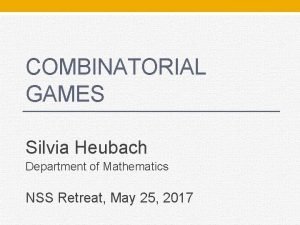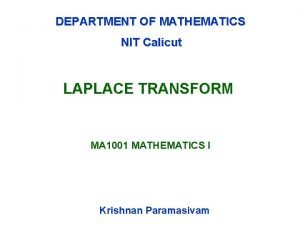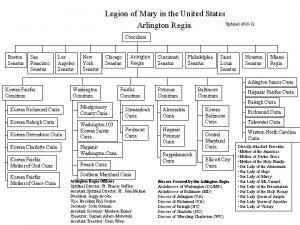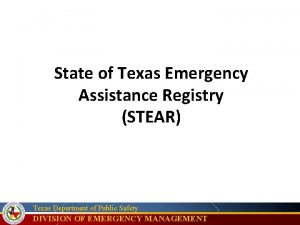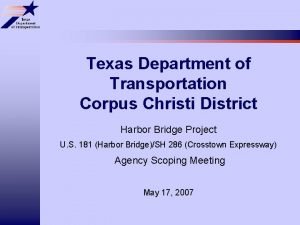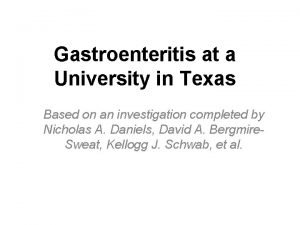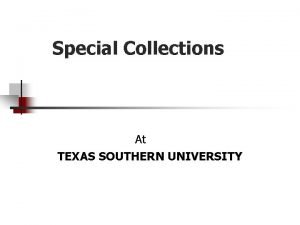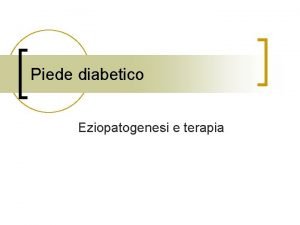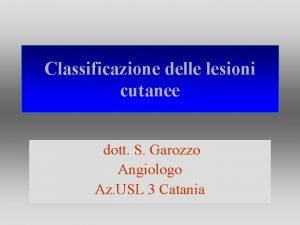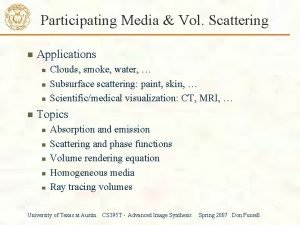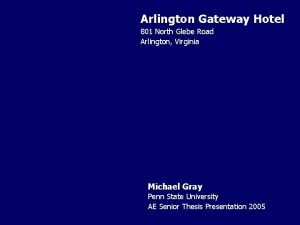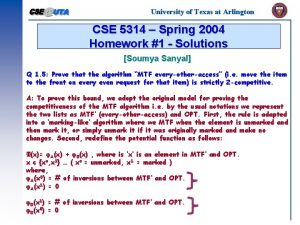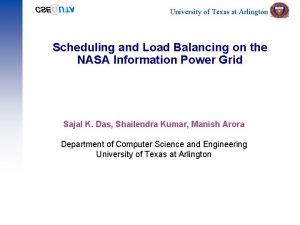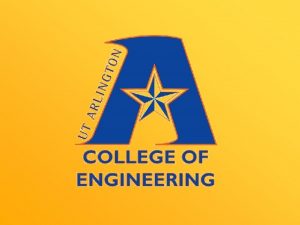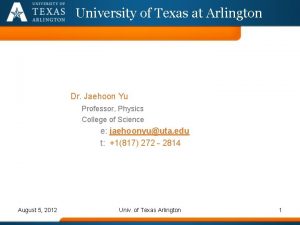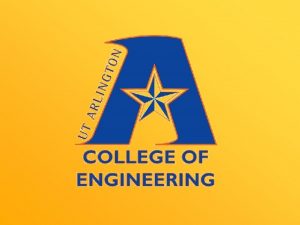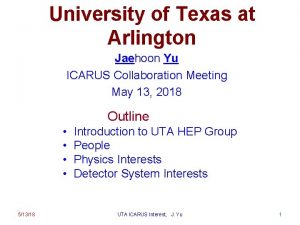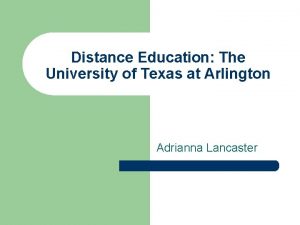University of Texas at Arlington Department of Mathematics





































- Slides: 37

University of Texas at Arlington Department of Mathematics High Order DNS and LES for Wing Tip Vortex and Flow Control Hua Shan, Li Jiang, Chaoqun Liu Department of Mathematics University of Texas at Arlington, TX 76019 (Supported by ONR, AFOSR, Lockheed, AFRL) February 2008

University of Texas at Arlington Department of Mathematics Outline 1. Introduction 2. Governing Equations and Numerical Algorithm 3. DNS and LES Results 4. Summary and Concluding Remarks

University of Texas at Arlington Department of Mathematics Introduction Engineering importance Wing tip vortex flows dominate the wakes of lifting vehicles Such flows are unsteady and very complicated, are considered to be the cause of noise, vibration and detectable signals, which could affect other objects (aircraft, propeller etc) following at a close distance Tip vortex can generate a low pressure core which could cause cavitation to damage blades of propeller or turbine machinery. The long lasting, strong low pressure core is also a main cause of damage of hurricane. Tip vortex is important to taking off and landing of an flight vehicle. Blade/vortex interactions can directly affect the performance of the rotorcraft such as propeller, helicopter etc The drag induced by wingtip vortex is significant Tip vortex control is of great engineering importance

University of Texas at Arlington Department of Mathematics Governing Equations The conservation form of 3 -D compressible Navier-Stokes equations in generalized curvilinear coordinates Filtered Structure Function Subgrid Model (Ducros et al. 1996)

University of Texas at Arlington Department of Mathematics Numerical Algorithm Second order Euler backward in time Sixth order compact central difference for spatial discretization LU-SGS implicit solver (Yoon, 1992) for time advancing High order compact filtering to suppress numerical oscillation Parallel computing based on domain decomposition and Message Passing Interface

University of Texas at Arlington Department of Mathematics Flow configuration Geometry: Rectangular half wing NACA 0012 wing section Rounded wingtip Symmetry condition 0. 75 c z o x c Uniform flow y

University of Texas at Arlington Department of Mathematics Grid distribution Grid number: 1024 x 160 (26 millions), one block Streamwise: Spanwise: Wall-normal: Grid overlapped region 5 grid points

University of Texas at Arlington Department of Mathematics DNS results – instantaneous flow field The iso-surfaceofaxial vorticity starts from the wing tip in the form of small vortical structures and evolves into a smooth (laminar) vortex tube in the further downstream of the wake. On the suction side the of wing, the flow near the tip region is highly 3 D and turbulent. Small vortical structures are clearly seen inside and around the tip vortex. Animation: Iso-surface of vorticity component x=3 Nearthetrailingedge, spiral wake surrounding the tip vortex is formed as the wake is skewed and laterally stretched and curved by the rotating velocity field associated with the tip vortex.

University of Texas at Arlington Department of Mathematics DNS results – instantaneous flow field (Cont’d) Along wing the vortex tip in the wake, the isosurfaces of positive and negative spanwise vorticity are parallel to each other in a vertical layout representing a typical spiral motion of velocity field. Animation: Iso-surface of vorticity component y= 3

University of Texas at Arlington Department of Mathematics DNS results – instantaneous flow field (Cont’d) Along the wing vortex tip in the wake, the iso-surfaces corresponding to the positive and the negative zcomponent of vorticity are parallel to each other in a horizontal layout representing a typical spiral motion of velocity field. Animation: Iso-surface of vorticity component z=± 3

University of Texas at Arlington Department of Mathematics DNS results – instantaneous flow field (Cont’d) structures are vortex The highly unsteady. The core area of the primary vortex is very unstable and the outer edge of the primary vortex is not smooth. separates layer shear The from the rounded wing tip and rolls up generating the primary vortex. Near junction the wing the of and the rounded tip, the secondary vortex is induced by the primary vortex and the secondary vortex rotates in the opposite direction of the primary vortex. The vorticity of small vortices shedding from wing tip shear layer has the same sign as the primary vortex Animation: Pressure contours and velocity vectors in the cross-section at x/c=0. 9

University of Texas at Arlington Department of Mathematics DNS results – instantaneous flow field (Cont’d) primary the of center The vortex moves upward away from the surface of the wing and the vortex core grows. secondary The also vortex grows. It rolls up and merges into the primary vortex. The secondary vortex brings unsteadiness and instability into the core of the primary vortex. interaction The between the primary and the secondary vortices leads to the generation of small vortical structures in the core area. Animation: Pressure contours and velocity vectors in the cross-section at x/c=0. 995

University of Texas at Arlington Department of Mathematics DNS results – instantaneous flow field (Cont’d) At the Immediate down-stream of the trailing edge, there is not any newly generated secondary vortices due to the absence of wall. The visible secondary vortical structures are actually the secondary vortices shed from the wing surface at the upstream location and convected downstream. Thesecondaryvorticesbecome weaker while traveling downstream, thus introduces less disturbance to the core of the primary vortex. The primary vortex is able to maintain an unbroken core all the time at this location. Animation: Pressure contours and velocity vectors in the cross-section at x/c=1. 06

University of Texas at Arlington Department of Mathematics DNS results – instantaneous flow field (Cont’d) Further downstream the from trailing edge of the wing, the secondary vortex is barely seen, because they are significantly dissipated while they are convected downstream. Because disappearance theof of the secondary vortex and the absence of the shear layer, no more disturbance is input to the primary vortex. The primary vortex is stabilized and is able to maintain a shape of a smooth regular circle. edge trailing Sometimes, the wake (from the lower left corner of the plot), being entrained by the primary vortex, rolls up into the primary vortex. When this happens, the shape and the position of the vortex core affected. Animation: Pressure contours and velocity vectors in the cross-section at x/c=1. 125

University of Texas at Arlington Department of Mathematics DNS results – instantaneous flow field (Cont’d) Duetothereasonsthathave been discussed in the previous slide, as one goes to a further downstream location, the primary vortex becomes more stable (relaminized). Animation: Pressure contours and velocity vectors in the cross-section at x/c=1. 25

University of Texas at Arlington Department of Mathematics DNS results – instantaneous flow field (Cont’d) The primary tip vortex becomes more stable. Animation: Pressure contours and velocity vectors in the cross-section at x/c=1. 45

University of Texas at Arlington Department of Mathematics DNS results – Reynolds shear stress (Cont’d) The contours of the v’w’ component of Reynolds stress show four-leaf clove pattern which was also observed in the experiments (Chow, et al, 1997). This pattern becomes more clear in the wake where the distortion effect of the shear layer vanishes. Contours of the v’w’ component of Reynolds stress in cross-sections at different axial locations

University of Texas at Arlington Department of Mathematics DNS results – Acoustic wave The distribution of pressure perturbation reveals the propagation of acoustic waves away from the wingtip. The pressure perturbations are closely associated with the fluctuations in the tip vortex and the separated turbulent shear layer. The formation of the wingtip primary vortex is considered as a major source of noise. Contours of RMS p’ in cross-sections at different axial locations

University of Texas at Arlington Department of Mathematics Preliminary Analysis of Tip Vortex Feature 1. Why the tip vortex is turbulent originally? 1) Wall surface is the resource of turbulence generation 2) Interaction of primary and secondary vortices 2. Why the tip vortex is relaminarized and stable after shedding? 1) There is no wall surface in the wake (no turbulence source) 2) The velocity in the tip vortex center becomes larger because of the rotation and the velocity profile of mean flow becomes jet-type (no deflection point) which is invicidly very stable. 3) The secondary vortex is quickly dissipated and does not disturb the primary vortex.

University of Texas at Arlington Department of Mathematics Concluding Remarks High Reynolds number (4. 6 x 106) complex flow associated with the formation of the wingtip vortex and its initial development and interaction with the near wake has been simulated by DNS. The high order, high resolution compact scheme enables this simulation to capture the major features using only about 24 million grid points. On the suction side of the wing surface, the rolling up of the separated shear layer at the rounded wingtip creates the primary tip vortex. The rotational flow field of the primary tip vortex induces the counter-rotating secondary vortex near the wing surface. The separated shear layer contains high level of fluctuations and wraps up the secondary vortex into the primary vortex. The shear layer fluctuations and the secondary vortex contribute high energy to the vortex core to produce small vortical structures within the core region which is highly turbulent. Therefore, the turbulence inside the primary tip vortex is not created by the tip vortex itself. The turbulent shear layer and the interaction between the primary and the secondary vortices are the major sources of turbulent activity in the core.

University of Texas at Arlington Department of Mathematics Concluding Remarks (Cont’d) In the near wake region, there is no more energy input from the shear layer and secondary vortex due to the absence of the wall surface. In the wake, the small vortical structures convected from the upstream dissipate rapidly. This is not only because of lack of turbulence source, but also because the mean flow profile is jet type without deflection point due to rotation which is strongly inviscid stable. The quick dissipation of secondary vortex is another reason to make tip vortex relaminized quickly. The near field wake is screwed and laterally stretched and curved by the rotating primary vortex. Wake disturbances contributes to the fluctuation of the primary vortex and dissipate quickly when traveling downstream. In further downstream, the tip vortex becomes more stable and flow in the core region is more axisymmetric. On the cross-sections that are intersected with the wing, peak values of velocity fluctuations are found over the suction side of the wing where the shear layer separates from the rounded wingtip. The high level fluctuations are wrapped up into the vortex core and convected downstream. In the wake region, the peak of velocity fluctuation appears in the center of the vortex core and fluctuation level decreases rapidly downstream along the axial direction. Pressure perturbation field shows that the noise source locates in the tip region and acoustic waves propagate away from the wingtip. The fluctuations inside the tip vortex contribute to the pressure perturbations.

University of Texas at Arlington Department of Mathematics Acknowledgment This work was sponsored by the Office of Naval Research (ONR) and monitored by Dr. Ron Joslin under grant number N 00014 -03 -1 -0492. The authors also thank the High Performance Computing Center of US Department of Defense for providing supercomputer hours.

University of Texas at Arlington Department of Mathematics (supported by AFOSR under grant F 49620 -01 -1 -0028) Contributed by Li Jiang and Chaoqun Liu University of Texas at Arlington

University of Texas at Arlington Department of Mathematics Spanwise vorticity

University of Texas at Arlington Department of Mathematics Spanwise vorticity

University of Texas at Arlington Department of Mathematics Spanwise vorticity

University of Texas at Arlington Department of Mathematics 3 -D movie for pitched and screwed jet – streamwise vortex

University of Texas at Arlington Department of Mathematics 3 -D movie for pitched and screwed jet – spanwise vortex

University of Texas at Arlington Department of Mathematics (supported by Lockheed Maritn) Contributed by Hua Shan, Li Jiang and Chaoqun Liu University of Texas at Arlington August, 2002

University of Texas at Arlington Department of Mathematics IV. Problem Formulation Flow separation over a NACA 0012 airfoil Angle of attack: = 6 Reynolds number based on free stream velocity and the chord length: Vortex Mach number: Generator C C 1 0. 0. 1 C 5 C 7 6 01 0. 6 C 0. 008 30. 96° 0. 02 C 18°

University of Texas at Arlington Department of Mathematics Number of grid points: 840 90 120

University of Texas at Arlington Department of Mathematics Animation. Contours of instantaneous spanwise vorticity on the mid-plane

University of Texas at Arlington Department of Mathematics Instantaneous Flow Field (Cont’d) x= 100 x= – 100 Isosurfaces of streamwise vorticity y= 30 Isosurfaces of spwanwise vorticity z= 50 z= – 50 Isosurfaces of wall-normal vorticity

University of Texas at Arlington Department of Mathematics IV. Problem Formulation Flow separation over a NACA 0012 airfoil Angle of attack: = 6 Reynolds number based on free stream velocity and the chord length: Vortex Mach number: Generator C C 1 0. 0. 1 C 5 C 7 6 01 0. 6 C 0. 008 30. 96° 0. 02 C 18°

University of Texas at Arlington Department of Mathematics Number of grid points: 840 90 120

University of Texas at Arlington Department of Mathematics Instantaneous Flow Field (Cont’d) Active Vortex Generator Animation. Contours of instantaneous spanwise vorticity on the mid-plane

University of Texas at Arlington Department of Mathematics Thank You
 Ut arlington msw
Ut arlington msw Ut arlington rankings
Ut arlington rankings Uta disciplinary probation
Uta disciplinary probation Jaehoon yu
Jaehoon yu Texas state psychology program
Texas state psychology program Science dadeschools
Science dadeschools Purdue math building
Purdue math building Department of mathematics
Department of mathematics Nit calicut mathematics department
Nit calicut mathematics department Evan stiles swimming
Evan stiles swimming St ann arlington
St ann arlington Missed connections arlington va
Missed connections arlington va Arlington county csb
Arlington county csb What is the rhyme and meter of miniver cheevy
What is the rhyme and meter of miniver cheevy Privitte
Privitte Legion of mary usa
Legion of mary usa Arlington ma zoning map
Arlington ma zoning map State of texas emergency assistance registry
State of texas emergency assistance registry Texas department of transportation corpus christi
Texas department of transportation corpus christi Ttu chemistry department
Ttu chemistry department Cris txdot
Cris txdot Texas lutheran university scholarships
Texas lutheran university scholarships Jonathan tyner
Jonathan tyner Gastroenteritis at a university in texas
Gastroenteritis at a university in texas Texas state rotc
Texas state rotc Texas state university flower
Texas state university flower Texas state university
Texas state university Texas state new student orientation
Texas state new student orientation Student business services texas state
Student business services texas state Texas southern university library
Texas southern university library University of texas wound classification system
University of texas wound classification system Classificazione texas university
Classificazione texas university Classificazione texas university
Classificazione texas university Library university of texas
Library university of texas University of texas
University of texas Ttu business services
Ttu business services University of texas
University of texas Tex state apartments
Tex state apartments







